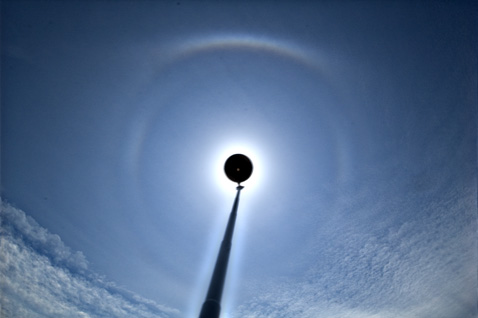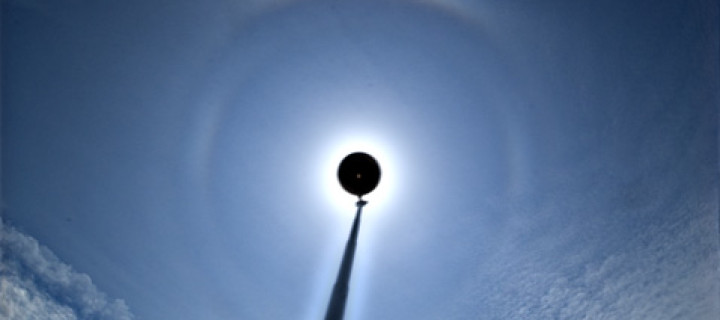
This display appeared today treacherously from behind Ac clouds. It did not last long, as Ac came to veil it again. 14 frames stack from 5 minutes.


This display appeared today treacherously from behind Ac clouds. It did not last long, as Ac came to veil it again. 14 frames stack from 5 minutes.
Cool! That looks similar to my display I got after the elliptical halo. Since there was AC did you see any elliptical halos?
This Ac was not giving icy virga, so no chances for ellipses.
Good job!
Same here..my display on 25th didn’t last long. The peak time was about 3-4 minutes overall and 8 stacks until the ice-clouds were swept away.
Nice display Krusel! Got there 20° and 24° halos, but no 18°. That’s rarer type of combination.
Thanks. Unfortunately the photographing location was terrible and I consider myself lucky with this treeless spot.
I’m still waiting pyramidial parhelias over here…looks like you Finnish guys have more luck with these !
Nice one there Marko K. That display I got has upper 23d plate arc possible 9 and 20d ca and it formed after the elliptical halo.
Krusel, you should be able to see at least one solitary 23 parhelia arc each summer assuming Estonia is not much different from Southern Finland. They are seen during hot weather periods, but can be seen also in the beginning of end of the period when it is not so hot. On many years during these periods 23 plate arc is more common than 22 upper tangent arc.
Often these solitary 23 parhelias are not actually solitary. Stacking should reveal very faint 9 halo and possibly 18 parhelia.
This was shot back in 2008 June. I guess this is a good candidate to meet the standards of the 23 plate arc. Of course the arc is not solitary but nevertheless it was a good display.
The fifth June display… Wonder how many years – decades – it takes to get another one.
Yeah the June 5th display thats one of the best odd radius halo displays yet. Yeaterday I got nice 18 and 23 degree plate arcs with their halos and have been doing photo stacks as well.
It is good there is odd radii. Otherwise interesting displays outside winter time would be too scarce to keep us alive.
Today I though of seeing a faint 9 halo so I went out to take a stack serie. I did not see anymore 9 halo, but it appears incompletely in first 10 frame stack.
Hope to see your photos soon, Michael.
Yeah I’ll have Agnes post them since the user interface is complicated rocket science and is difficult to use.
I still have not finished the stacks yet and when I do mine I do it manually. I do one where photos are unprocessed and then another with USM.
Don’t worry I’ll GIT R DONE!:)
Michael, you just do one without usm and then usm that. The result is the same as if you would stack usmed individual photos.
Yeah, you are right about the blog interface.
Looking forward to get your photos for posting, Michael!
Marko
I did that and the composite looked ugly showing wavy artifacts that were discolored.
Hang in there Agnes I’ll GIT R DONE!:) Its raining right now and have nothing better to do except internet and run my lathe and turn wood into custom bowls and vases to sell.
Michael, you get those artefacts if your photos are 8bit. Next time take RAW photos (and make sure to open them in photoshop as as 16bit).
Raining here in Tampere as well.
Michael, I gave a presentation about the matters regarding bit depth, RAW and post processing in the last halo meeting that was held in Finland.
If you want, I can send you the slides.
Marko and I have been discussing this unsharp masking order from the beginning of times… Sometimes, yeah, those wavy artifacts become visible if you only usm the stackked photo in the end. Sometimes it does not make any difference whether you usm the individual frames or the single stackked one. And of course you are always working with 16 bit tiffs.
I have found it quite easy to instruct a photo processing program to do usm to each individual frame. Once you ignite the process the computer will batch the rest without your involvement. This extra step assures that the possibly emerging wavy artefacts are smoothened out (almost completely). 12 bit RAWs or not, I sometimes get those artifacts.
I have never encountered these artifacts unless the file has been to 8-bit at some point. Perhaps some of the actions drop the bit depth without user approval.
As I found out the quality of your cameras chips plays the biggest role in this imaging process…use always the lowest possible iso settings and shoot raw. In camera keep the image parameter settings moderate – don’t over-saturate and over-contrast, of course when shooting raw you can always change these values later but depending on the amount of shots and your cameras manufacturer software it could be pain in the ass afterwards.
I could do RAW images but they just like tifs they take up too much hard disk space.
I was thinking along the same lines until Jari talked me over going on RAW. These days, realizing that I had accidentally photographed a good display in JPG would an event of horror.
Well said MarkoR, anything below RAW is from evil.